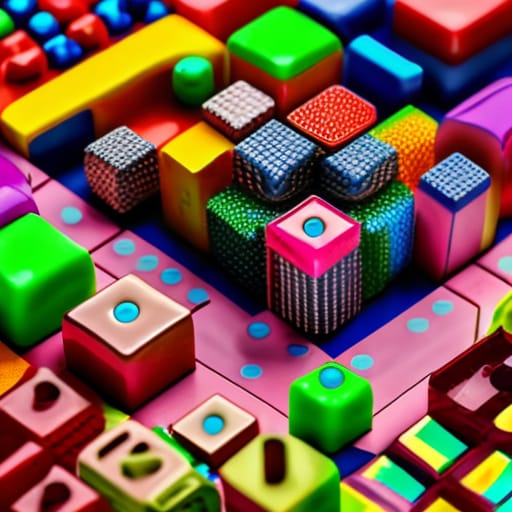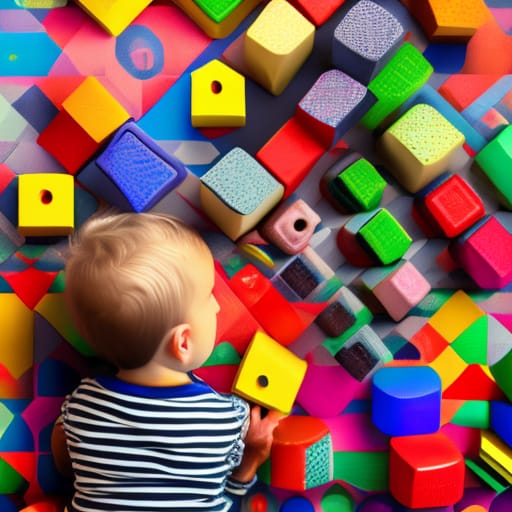Magnetic blocks are versatile educational toys that inspire open-ended building and imaginative play. With their ability to attach to metal surfaces and connect together, large magnetic blocks facilitate engaging STEM learning activities that develop young children’s cognitive, motor, and social skills. This beginner’s guide will explore the key benefits of large magnetic blocks and provide recommendations to help parents and teachers integrate them into early childhood education.
What Are Large Magnetic Blocks?
Large magnetic blocks refer to oversized building blocks or tiles embedded with magnets to enable attachment and stacking. Available in a variety of bright colors and shapes like circles, squares, triangles, and rectangles, these blocks snap together through magnetic force to allow children to construct creations and structures.
Unlike small magnet sets, large magnetic blocks feature powerful neodymium iron boron (NdFeB) magnets encased in thick ABS plastic for durability and safety. With edge lengths ranging from 2 to 5 inches, the blocks are sized appropriately for little hands to manipulate and are designed to withstand rugged play. Sets range from a couple dozen pieces to over 100 blocks and tiles of varying types to spark creativity.
Key Benefits of Using Large Magnetic Blocks
Integrating large magnetic blocks into early childhood education environments provides multifaceted benefits:
- Develop STEM skills: Building structures with magnetic blocks promotes spatial reasoning, shape recognition, counting, fine motor control, and problem-solving abilities.
- Encourage creativity and imagination: The possibilities are endless when it comes to constructing new designs. Children are free to experiment and express themselves.
- Inspire cooperative play: Whether working together on structures or imagining exciting scenarios with their creations, shared play with magnetic blocks helps children learn collaboration, communication, sharing, and compromise.
- Teach perseverance and critical thinking: Magnetic structures may collapse if imbalanced, but children can analyze designs and attempt new solutions until achieving desired results. This process builds resilience, curiosity, and critical analysis.
- Reinforce educational concepts: Educators can design magnetic block activities to illustrate science, technology, engineering, art, and math topics across the early childhood curriculum to deepen understanding.
- Engage sensory learners: The satisfying “click” when magnetic blocks connect provides helpful audio feedback. Smooth block surfaces, vibrant colors, and gravity-defying structures also appeal to visual and tactile young learners.
As versatile, open-ended manipulatives, large magnetic blocks empower children to take the lead in play-based discovery and learning across developmental domains.

Types of Large Magnetic Blocks
Large magnetic blocks are available from top manufacturers in various shapes, sizes, and configurations:
| Type | Description |
|---|---|
| Magnetic building tiles | Colorful square, triangular, hexagonal, rectangle tiles that connect like puzzle pieces to build 2D creations on flat surfaces |
| Magnetic building blocks | Cubes, rectangles, arches, and specialty blocks that connect on all sides to enable 3D magnetic construction |
| Magnetic pattern blocks | Blocks etched with shapes, Numbers, letters, operations for early math and literacy foundations |
| Magnetic baseplates | Plastic grids with embedded magnets to provide a foundation for building magnetic structures |
| Magnetic frames and boards | Sturdy open frames, boards with magnetic surfaces allow vertical or tabletop display of magnetic creations |
Whether snapping magnetic tiles into colorful mosaics or stacking magnetic building blocks high into imaginative towers, each type of large magnetic block set offers open-ended building fun while nurturing development.
Top Recommended Magnetic Block Sets
With countless magnetic block options on the market, here are top-rated large magnetic block sets from leading manufacturers to consider:<div class=”table-wrap” markdown=”block”>
| Product | Description | Price |
|---|---|---|
| Grippies Builders Magnetic Building Set | 100-piece set with cubes, rectangles, triangles, wheels promotes open-ended building | $39.99 |
| PLAYMOBIL Magnetic Building Blocks Set | 60-piece set with magnetic baseplates, cubes, triangles, rectangles for versatile building | $27.99 |
| Magna-Tiles Clear Colors 100 Piece Set | Award-winning magnetic 3D building tiles in assorted shapes ideal for STEM education | $124.99 |
| Tegu Magnetic Wooden Block Set | Innovative 24-piece magnetic wooden building set made of sustainable wood | $49.99 |
| Magformers Basic Set 30 Piece | 30 magnetic squares, triangles in bright colors that connect on all sides from leading classroom supplier Lakeshore Learning | $64.99 |
With powerful magnets, premium durable components, and open-ended configurations, these block sets inspire creativity while developing key foundation skills.
Using Magnetic Blocks Across the Early Childhood Curriculum
In addition to free building activities, magnetic blocks offer engaging hands-on learning games and challenges tailored to curriculum standards from preschool through early elementary grades:
Math Manipulatives
- Have students build structures to represent counting, addition/subtraction, patterns, shapes, fractions, measurement, place value
- Sort magnetic blocks by color, shape, size, orientation
- Sequence blocks by size to visualize comparison
Literacy Development
- Build letters, sight words, names with magnetic blocks
- Magnets attach to metal alphabet cookie sheets to practice spelling
- Use blocks to retell stories and sequencing events
Science and Sensory Play
- Demonstrate forces like push/pull, gravity, and magnetism through block play
- Explore color mixing, light, and reflection with transparent blocks
- Compare weights, sounds, textures, temperatures of blocks
Art and Design
- Have students plan and engineer structures from idea to outcome
- Mix colors and shapes to create artistic flat mosaics and 3D sculptures
Music and Movement
- Build along to rhythms by adding/removing blocks
- Dance movements with magnetic wands to rearrange wall designs
With thoughtful activities aligned to learning goals across disciplines, magnetic blocks offer versatile hands-on experiences to engage young students while reinforcing key skills.

Guidelines for Introducing Magnetic Blocks
To safely maximize the benefits of magnetic blocks in early childhood environments:
- Supervise students during all magnetic block activities
- Demonstrate how to gently pull blocks apart using fingertips
- Store blocks out of reach of very young children
- Check that all magnets are properly encased in blocks before use
- Monitor collaborative building to encourage sharing
- Remind students not to throw blocks or build too high without support
- Allow creativity to flourish by avoiding prescribed structures
With thoughtful guidelines and engaged supervision, magnetic blocks offer tremendous potential for multi-dimensional learning through joyful hands-on play.
Takeaways on Magnetic Blocks for Early Education
- Oversize magnetic blocks featuring strong embedded magnets deliver open-ended building play for early learning.
- Available as tiles, cubes, arches and more, magnetic blocks connect through magnetic force to enable creation of 2D mosaics and 3D structures.
- Key benefits include developing STEM skills, inspiring creativity, teaching teamwork and resilience through block challenges that collapse and must be rebuilt.
- Leading magnetic block sets provide versatile, developmentally appropriate manipulatives to reinforce educational concepts across the early childhood curriculum.
- With proper supervision and reasonable safety measures, magnetic blocks empower young children to explore, experiment, and engineer unique hands-on learning experiences.
Embracing magnetic blocks as flexible educational manipulatives builds critical 21st century skills through joyful, engaging play. By unleashing children’s innate creativity, persistence and problem-solving abilities, large magnetic blocks equip young learners for future academic and career success.
Frequently Asked Questions About Magnetic Blocks
What are the best magnetic building blocks for toddlers?
For toddlers ages 1-3, choose larger sized blocks like Grippies or Magna-Tiles Clear Colors sets with cubes, chunky rectangles, and textured edges for easy grasping. Avoid small pieces that pose a choking risk.
How do magnetic tiles attach together?
Magnetic tiles feature neodymium magnets encased in thick plastic that generate a forceful push-pull attraction through the tiles. This allows tiles to connect securely side-to-side and stack up into colorful mosaics.
Can I build on magnetic baseplates?
Yes, sturdy magnetic baseplates act like metal grids to provide a foundation for building structures with magnetic blocks. Baseplates often feature grids with patterns, roads, landscapes, building sites and more for pretend imaginative play.
Are wooden magnetic blocks safe for kids?
High quality wooden magnetic block sets like Tegu feature powerful neodymium magnets completely sealed within smooth wooden blocks making them safe and durable. Always supervise young kids during block play regardless of material.
Do magnetic blocks help develop STEM skills?
Yes, researching, planning, designing and problem-solving challenges that arise during magnetic block construction promotes key science, technology, engineering and math skills from early ages. Open-ended magnetic block play lays the foundation for later STEM success.
